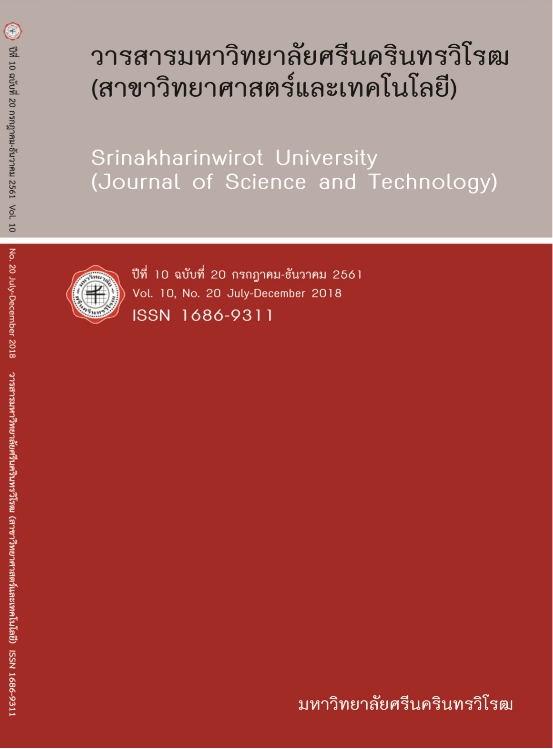การหาสภาวะที่เหมาะสมของการสกัดน้ำมันจากเมล็ดมะละกอด้วยไมโครเวฟช่วยสกัด โดยใช้วิธีพื้นผิวตอบสนอง OPTIMIZATION OF MICROWAVE-ASSISTED EXTRACTION OF PAPAYA SEED OIL BY RESPONSE SURFACE METHODOLOGY
Keywords:
Oil Extraction, Papaya Seed, Microwave-Assisted Extractio, Response Surface MethodologyAbstract
The purpose of this research was to optimize the condition for oil extraction from papaya seed by microwave-assisted extraction (MAE) was carried out using response surface methodology (RSM) with central composite design (CCD) to achieve the highest extraction efficiency and reduce energy consumption. The three independent variables were extraction time (X1), microwave power (X2) and papaya seed to solvent ratio (X3). The dependent (response) variable was oil extraction yield. Twenty experiments were performed according to the design. It was predicted that the optimum extraction conditions were extraction time of 2.32 minute, microwave power of 800 watts and papaya seed to solvent ratio of 7%, which resulted in an oil extraction yield of 28%. The coefficients of determination were found to be very high (R2 = 0.974). Comparison of the experimental values with those of the predicted values was consistent. The accuracy of model predictions was 86.2%. Hence, the regression model derived from the experimental data adequately described the correlation among the three independent variables studied and provided accurate prediction of the papaya seed oil yield obtained by MAE.
Downloads
References
[2] Chielle, D.P.; Bertuol, D.A.; Meili, L.; Tanabe, E.H.; and Dotto, G.L. (2016). Convective drying of papaya seeds (Carica papaya L.) and optimization of oil extraction. Industrial Crops and Products. 85: 221–228.
[3] Samaram, S.; Mirhosseini, H.; Tan, C.P.; Ghazali, H.M.; Bordbar, S.; and Serjouie, A. (2015). Optimisation of ultrasound-assisted extraction of oil from papaya seed by response surface methodology: Oil recovery, radical scavenging antioxidant activity, and oxidation stability. Food Chemistry. 172: 7–17.
[4] Samaram, S.; Mirhosseini, H.; Tan, C.P.; and Ghazali, H.M. (2014). Ultrasound-assisted extraction and solvent extraction of papaya seed oil: Crystallization and thermal behavior, saturation degree, color and oxidative stability. Industrial Crops and Products. 52: 702–708.
[5] Lee, W.-J.; Lee, M.-H.; and Su, N.-W. (2011). Characteristics of papaya seed oils obtained by extrusion-expelling processes. Journal of the Science of Food and Agriculture. 91(13): 2348–2354.
[6] Samaram, S.; Mirhosseini, H.; Tan, C.; and Ghazali, H. (2013). Ultrasound-assisted extraction (UAE)and solvent extraction of Papaya seed oil: Yield, fatty acid composition and Triacylglycerol profile. Molecules. 18(10): 12474–12487.
[7] Wan, H.B.; and Wong, M.K. (1996). Minimization of solvent consumption in pesticide residue analysis. Journal of Chromatography A. 754(1-2): 43–47.
[8] Poole, C.F.; and Poole, S.K. (1996). Highlight. Trends in extraction of semi-volatile compounds from solids for environmental analysis. Analytical Communications. 33(7): 11H.
[9] Camel, V. (2000). Microwave-assisted solvent extraction of environmental samples. TrAC Trends in Analytical Chemistry. 19(4): 229–248.
[10] Sparr Eskilsson, C.; and Björklund, E. (2000). Analytical-scale microwave-assisted extraction. Journal of Chromatography A. 902(1): 227–250.
[11] AOAC. (1999). Official Methods of Analysis Association of Official Analytical Chemists. 16th Washington, D.C.
[12] AOAC. (2000). Official Methods of Analysis Association of Official Analytical Chemists. 17th Volume I. USA.
[13] Subseree, J. (2009). DOE Central Composite Design. Retrieved June 4, 2016, fromhttp://www.tpa.or.th/publisher/pdfFileDownloadS/FQ145_p72-74.pdf
[14] Plohtpleuang, R. (2014). Factors Affecting Microwave-Assisted Extraction of Antioxidant FromRed Grape Promace. Master’s Thesis, King Mongkut's Institute of Technology Ladkrabang.
[15] Ziegel, E.R.; Khuri, A.; and Cornell, J. (1997). Response surfaces: Designs and analyses. Technometrics. 39(3): 342.
[16] Boonyanuch, C.; and Kittichai, B. (2016). Kinetics Study of Grape Seed Oil Microwave-Assisted Solvent Extraction. In Proceeding of Food Innovation Asia Conference 2016. pp. 442-448. Bangkok. Thailand.
[17] Golfarelli, M.; Rizzi, S.; and Proli, A. (2006). Designing what-if analysis: towards a methodology. In Proceedings of the DOLAP. Arlington, VA. pp. 51–58.
[18] Kleijnen, J.P.C. (1995). Sensitivity analysis and optimization in simulation models: design of experiments and case studies. In Proceeding Winter Simulation Conference. n.p.
[19] Ozturk, E. (2012). "What if" Analyses: Ways to Interpret Statistical Significance Test Results using EXCEL or "R". In the annual meeting of the Southwest Educational Research Association. n.p.
[20] Marfo, E.K.; Oke, O.L.; and Afolabi, O.A. (1986). Chemical composition of papaya (Carica papaya) seeds. Food Chemistry. 22(4): 259–266.
Downloads
Published
How to Cite
Issue
Section
License
Srinakharinwirot University Journal of Sciences and Technology is licensed Under a Creative Commons Attribution-NonCommercial-NoDerivs 4.0 International (CC-BY-NC-ND 4.0) License, Unless Otherwise Stated. Please Read Journal Policies Page for More Information on Open Access, Copyright and Permissions.



